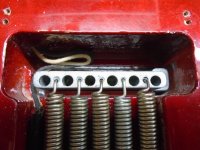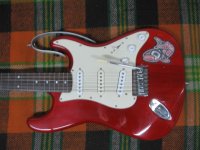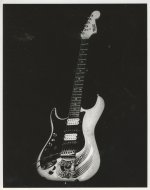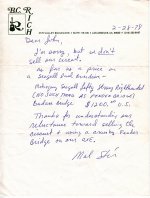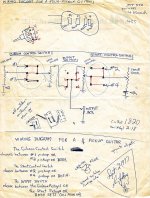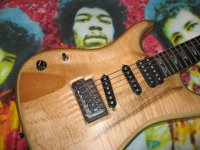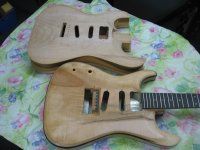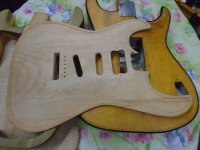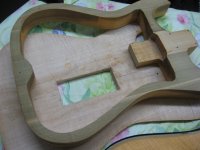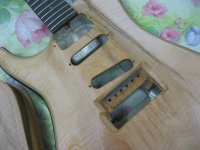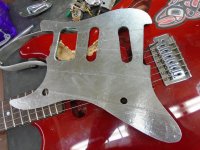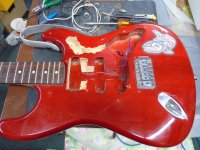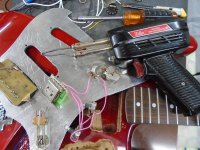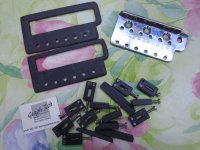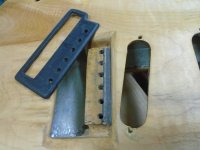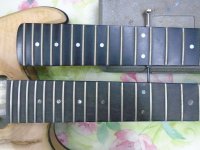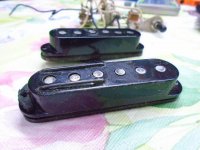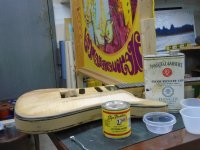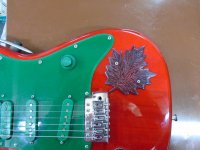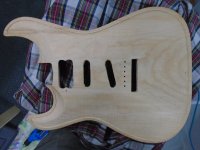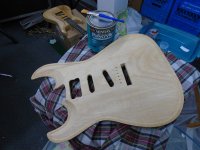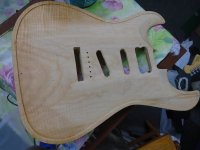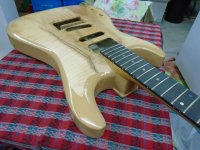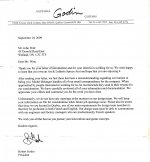John Watt
Member
When Leo Fender invented the Stratocaster it was his version of a stand-up steel guitar.
The tremolo unit was his biggest innovation, something never before seen in music history.
That was having individual, two-way adjustable bridge pieces for each string.
That allowed each string to be tuned scientifically using an oscilloscope,
what TV repairmen used to analyze their electronics.
That's why Jimi Hendrix, with his U.S. Air Force radar technician background,
could use a Stratocaster for multiple overdubs that blended, even with tape recorders.
He also hired an electrical inventor to create a phase shifter and flanger,
radar properties that scientific tuning allowed to work with electric guitars and amplifiers.
When Leo Fender owned his own company, the guitars he built were the guitars he built.
He didn't change them to be this years' new model, or offer upgrades, only accessories.
You could take the neck off a Jaguar, Stratocaster, Telecaster, Jazzmaster or Deluxe,
and it would be interchangeable with any of those models.
Beyond the individual bridge pieces, the Stratocaster had other features that Jimi used.
And that's playing one with feedback, using the response of your amplifier as musical sound.
The pick-guard had an aluminum plate behind it, seeing a thin line of silver around the edge.
That was left-over newspaper printing aluminum, when type-facing was inked onto it,
what I used when I put together my first left-handed Stratocaster replica.
If you were playing with a Marshall stack, the only amplifier back then with chest high speakers,
the amount of pick-guard you let it see, moving your guitar out beside your body,
a little, half-way or all the way, and then turning to face the amplifier,
all created various levels of feedback response, depending on additional effects.
When I say American manufacturing, one of Leo Fenders' big suppliers was the army.
A lot of his electronics and metal sheeting were war surplus after World War Two.
You could take the electrical panel off an amplifier and see war applications printed on it.
Back then, American manufacturing played the public with two different value systems,
Fender being 250k for volume and tone controls with Gibson being 500k.
Having a plastic pick-guard was new and as different as parts installed in the body.
Gibson would use electrical paint inside the holes, er, chambers, for the pickups and electronics,
something else that added to the debate about the worth of these bi-polar designs.
To be more specific, when Jimi Hendrix was alive, it was all about 1960 to '64 Strats.
Those were the years when the "thin-line" neck came out,
when previous manufacture had rounder, almost half-round, necks,
what was typical for most guitar builders and manufacturers back then.
The scallop at the back of the body, to be form-fitting and slant the guitar up,
so you could see it better standing up, and the slanted body top,
that allowed easier arm motion above the body, from the start, were easier than the neck.
This combination of thin-line neck and contoured body has become the most popular design in the world.
Unfortunately, in North America where guitars and amplifiers are over-saturated in society,
the desire for cheaper prices has resulted in cheaper guitars that shouldn't be called Stratocasters.
This new thread has been motivated by two new online experiences for me.
The first is seeing my name beside a previous thread reply as being on the forum too long,
and the second was looking at a few You Tube videos where Strat tremolo tune-ups are shown.
Other guitarists were showing how to set one up so that it stays in tune,
and some were even saying they could set it up as a "floating tremolo" that stays in tune.
No-one was saying how to set up a Stratocaster tremolo unit so it operated properly.
Not only was staying in tune of great concern for Leo Fender,
but how the guitar worked when you were using it was also part of his design.
And that was motivated by the increase of breaking strings while you played.
Strings weren't what they are today, and I see Ernie Ball as changing all of that.
Guitarists who wanted to bend strings were buying banjo strings,
to get .008 and .009 for the high E, usually using banjo strings for the top two or three,
stepping down Fender or Gibson strings to round out the gauge.
If your tremolo unit is set up properly, when you break a string the ball end pops out the back,
and you can feel it, and the string length shoots off the tuner like an arrow.
All you have to do is put on a new one. That's how it's always worked for me.
What are off-shore Strats might have all the parts supplied by Fender,
except for the more labour intensive body, or be remade differently to be new manufacture,
to beat American intellectual property laws that could be of concern for National Security.
Hey! Having foreign Coca-Cola manufacturing facilities being "threatened" by locals,
who might have simply been looking for higher wages and less hours,
has been enough reason for American military to move in to "protect" this asset.
That's why you can buy some Stratocasters that look like Stratocasters,
and they can be Fender product from the States or offshore, or just offshore.
But basically, they don't work the same and never will, unless you rebuild them.
Your momma and poppa knew, you get what you pay for.
I'm hoping to create a dialogue with other Stratocaster players,
and by the time I finish describing various aspects of Strat manufacture,
and how to rebuild them,
this thread should not only keep me busy, but help others see what they can do.
Here's my challenge to you.
Why pay a minimum of $1,200 American for a California made Stratocaster,
and just take what you get,
when you can find one for $100 or less to rebuild it and change it to be more of who you are?
The original Stratocaster had the longest string length of any guitar being made,
and many offshore are smaller scale, so you have the best of both neck feels on offer.
Even if you have always been a Gibson player, with the shorter scale,
you can now look to a Stratocaster design as being playable with the same neck action.
I'm going to mention the aluminum sheet behind the pick-guard again,
and that's my rebuild for today, something that doesn't need a photo.
Most offshores don't even have foil or tape behind the entire pick-guard,
just foil around the volume and tone controls or just around the volume control.
Before any talk of improving the electronics and getting all the electric guitar signals,
you have to get a sheet of proper aluminum behind the entire pick-guard.
Using that as a ground is part of the original Stratocaster design, and you need that.
Cut out a rough shape, use body screws to hold it to the pickguard,
and start filing away, taking your time, and slowly get a perfect fit and outside edge.
Seeing that silver shine around the edge of the pick-guard is an expensive look,
and one that elevates any plastic pick-guard up off the wood body into the stratosphere.
Where I live, no, I don't need to prove I'm legit, but here, on this international forum, I do.
Here's a photo and scan combination of me in 1970, five months before Jimi passed away,
playing a 1964 Stratocaster I changed to be more left-handed,
showing the May 1st receipt for final payment, with a Marshall warranty,
and Bill Nitransky, founding owner of Central Music, a second father for me.
And after we get into the total Stratocaster, I will, as inventor of the semi-solid-body,
show you how to improve the original design for a wider musical experience.
This thread is dedicated to James Marshall Hendricks, "Jimi Hendrix", who I saw in 1969.
May All Peace Be Upon Us.
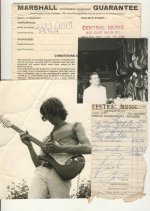
The tremolo unit was his biggest innovation, something never before seen in music history.
That was having individual, two-way adjustable bridge pieces for each string.
That allowed each string to be tuned scientifically using an oscilloscope,
what TV repairmen used to analyze their electronics.
That's why Jimi Hendrix, with his U.S. Air Force radar technician background,
could use a Stratocaster for multiple overdubs that blended, even with tape recorders.
He also hired an electrical inventor to create a phase shifter and flanger,
radar properties that scientific tuning allowed to work with electric guitars and amplifiers.
When Leo Fender owned his own company, the guitars he built were the guitars he built.
He didn't change them to be this years' new model, or offer upgrades, only accessories.
You could take the neck off a Jaguar, Stratocaster, Telecaster, Jazzmaster or Deluxe,
and it would be interchangeable with any of those models.
Beyond the individual bridge pieces, the Stratocaster had other features that Jimi used.
And that's playing one with feedback, using the response of your amplifier as musical sound.
The pick-guard had an aluminum plate behind it, seeing a thin line of silver around the edge.
That was left-over newspaper printing aluminum, when type-facing was inked onto it,
what I used when I put together my first left-handed Stratocaster replica.
If you were playing with a Marshall stack, the only amplifier back then with chest high speakers,
the amount of pick-guard you let it see, moving your guitar out beside your body,
a little, half-way or all the way, and then turning to face the amplifier,
all created various levels of feedback response, depending on additional effects.
When I say American manufacturing, one of Leo Fenders' big suppliers was the army.
A lot of his electronics and metal sheeting were war surplus after World War Two.
You could take the electrical panel off an amplifier and see war applications printed on it.
Back then, American manufacturing played the public with two different value systems,
Fender being 250k for volume and tone controls with Gibson being 500k.
Having a plastic pick-guard was new and as different as parts installed in the body.
Gibson would use electrical paint inside the holes, er, chambers, for the pickups and electronics,
something else that added to the debate about the worth of these bi-polar designs.
To be more specific, when Jimi Hendrix was alive, it was all about 1960 to '64 Strats.
Those were the years when the "thin-line" neck came out,
when previous manufacture had rounder, almost half-round, necks,
what was typical for most guitar builders and manufacturers back then.
The scallop at the back of the body, to be form-fitting and slant the guitar up,
so you could see it better standing up, and the slanted body top,
that allowed easier arm motion above the body, from the start, were easier than the neck.
This combination of thin-line neck and contoured body has become the most popular design in the world.
Unfortunately, in North America where guitars and amplifiers are over-saturated in society,
the desire for cheaper prices has resulted in cheaper guitars that shouldn't be called Stratocasters.
This new thread has been motivated by two new online experiences for me.
The first is seeing my name beside a previous thread reply as being on the forum too long,
and the second was looking at a few You Tube videos where Strat tremolo tune-ups are shown.
Other guitarists were showing how to set one up so that it stays in tune,
and some were even saying they could set it up as a "floating tremolo" that stays in tune.
No-one was saying how to set up a Stratocaster tremolo unit so it operated properly.
Not only was staying in tune of great concern for Leo Fender,
but how the guitar worked when you were using it was also part of his design.
And that was motivated by the increase of breaking strings while you played.
Strings weren't what they are today, and I see Ernie Ball as changing all of that.
Guitarists who wanted to bend strings were buying banjo strings,
to get .008 and .009 for the high E, usually using banjo strings for the top two or three,
stepping down Fender or Gibson strings to round out the gauge.
If your tremolo unit is set up properly, when you break a string the ball end pops out the back,
and you can feel it, and the string length shoots off the tuner like an arrow.
All you have to do is put on a new one. That's how it's always worked for me.
What are off-shore Strats might have all the parts supplied by Fender,
except for the more labour intensive body, or be remade differently to be new manufacture,
to beat American intellectual property laws that could be of concern for National Security.
Hey! Having foreign Coca-Cola manufacturing facilities being "threatened" by locals,
who might have simply been looking for higher wages and less hours,
has been enough reason for American military to move in to "protect" this asset.
That's why you can buy some Stratocasters that look like Stratocasters,
and they can be Fender product from the States or offshore, or just offshore.
But basically, they don't work the same and never will, unless you rebuild them.
Your momma and poppa knew, you get what you pay for.
I'm hoping to create a dialogue with other Stratocaster players,
and by the time I finish describing various aspects of Strat manufacture,
and how to rebuild them,
this thread should not only keep me busy, but help others see what they can do.
Here's my challenge to you.
Why pay a minimum of $1,200 American for a California made Stratocaster,
and just take what you get,
when you can find one for $100 or less to rebuild it and change it to be more of who you are?
The original Stratocaster had the longest string length of any guitar being made,
and many offshore are smaller scale, so you have the best of both neck feels on offer.
Even if you have always been a Gibson player, with the shorter scale,
you can now look to a Stratocaster design as being playable with the same neck action.
I'm going to mention the aluminum sheet behind the pick-guard again,
and that's my rebuild for today, something that doesn't need a photo.
Most offshores don't even have foil or tape behind the entire pick-guard,
just foil around the volume and tone controls or just around the volume control.
Before any talk of improving the electronics and getting all the electric guitar signals,
you have to get a sheet of proper aluminum behind the entire pick-guard.
Using that as a ground is part of the original Stratocaster design, and you need that.
Cut out a rough shape, use body screws to hold it to the pickguard,
and start filing away, taking your time, and slowly get a perfect fit and outside edge.
Seeing that silver shine around the edge of the pick-guard is an expensive look,
and one that elevates any plastic pick-guard up off the wood body into the stratosphere.
Where I live, no, I don't need to prove I'm legit, but here, on this international forum, I do.
Here's a photo and scan combination of me in 1970, five months before Jimi passed away,
playing a 1964 Stratocaster I changed to be more left-handed,
showing the May 1st receipt for final payment, with a Marshall warranty,
and Bill Nitransky, founding owner of Central Music, a second father for me.
And after we get into the total Stratocaster, I will, as inventor of the semi-solid-body,
show you how to improve the original design for a wider musical experience.
This thread is dedicated to James Marshall Hendricks, "Jimi Hendrix", who I saw in 1969.
May All Peace Be Upon Us.

Last edited:

